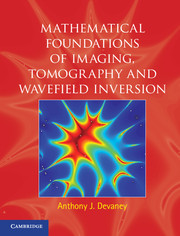Book contents
- Frontmatter
- Contents
- Preface
- 1 Radiation and initial-value problems for the wave equation
- 2 Radiation and boundary-value problems in the frequency domain
- 3 Eigenfunction expansions of solutions to the Helmholtz equation
- 4 Angular-spectrum and multipole expansions
- 5 The inverse source problem
- 6 Scattering theory
- 7 Surface scattering and diffraction
- 8 Classical inverse scattering and diffraction tomography
- 9 Waves in inhomogeneous media
- 10 Time-reversal imaging for systems of discrete scatterers
- 11 The electromagnetic field
- Appendix A Proof of the scattering amplitude theorems
- Appendix B Derivation of the generalized Weyl expansion
- References
- Index
6 - Scattering theory
Published online by Cambridge University Press: 05 July 2012
- Frontmatter
- Contents
- Preface
- 1 Radiation and initial-value problems for the wave equation
- 2 Radiation and boundary-value problems in the frequency domain
- 3 Eigenfunction expansions of solutions to the Helmholtz equation
- 4 Angular-spectrum and multipole expansions
- 5 The inverse source problem
- 6 Scattering theory
- 7 Surface scattering and diffraction
- 8 Classical inverse scattering and diffraction tomography
- 9 Waves in inhomogeneous media
- 10 Time-reversal imaging for systems of discrete scatterers
- 11 The electromagnetic field
- Appendix A Proof of the scattering amplitude theorems
- Appendix B Derivation of the generalized Weyl expansion
- References
- Index
Summary
In the radiation problem treated in Chapters 1 and 2 a “source” q(r, t) in the time domain or Q(r, ω) in the frequency domain radiated a wavefield that satisfied either the inhomogeneous wave equation in the time domain or the inhomogeneous Helmholtz equation in the frequency domain. In either case the solution to the radiation problem was easily obtained in the form of a convolution of the given source function with the causal Green function of the wave or Helmholtz equation. A key point concerning the radiation problem is that the source to the radiated field is assumed to be known (specified) and is assumed to be independent of the field that it radiates. Such sources are sometimes referred to as “primary” sources since the mechanism or process that created them is unknown or, at least, unimportant as regards the field that they radiate.
In this chapter we will also encounter the radiation problem, but with sources that are created by the interaction of a propagating wave incident on a physical obstacle or inhomogeneous region of space. These new types of sources are referred to as “induced” or “secondary” sources and the problem of computing the field that they radiate given the incident wave and a model for the field-obstacle interaction is called the scattering problem. We deal with two classes of scattering problem in this book: (i) scattering from so-called “penetrable” scatterers, where the incident wave penetrates into the interior of the obstacle so that the resulting induced source radiates as a conventional volume source of the type treated in earlier chapters; and (ii) scattering from non-penetrable scatterers, where the interaction of the incident wave with the obstacle occurs only over the object's surface.
- Type
- Chapter
- Information
- Publisher: Cambridge University PressPrint publication year: 2012



